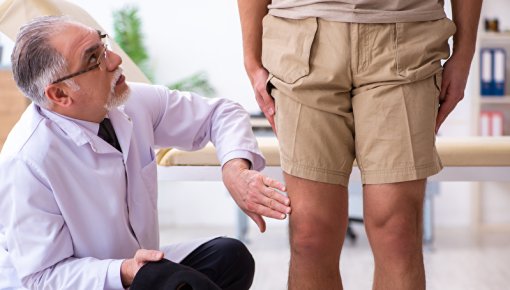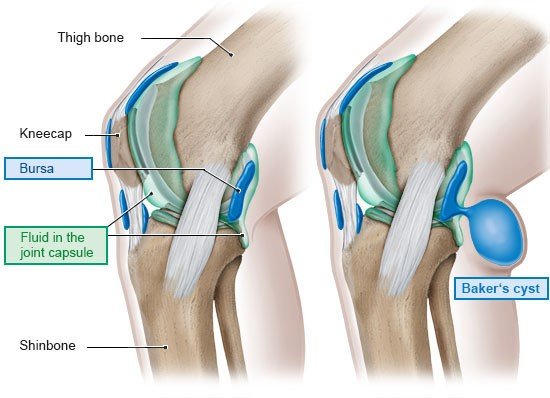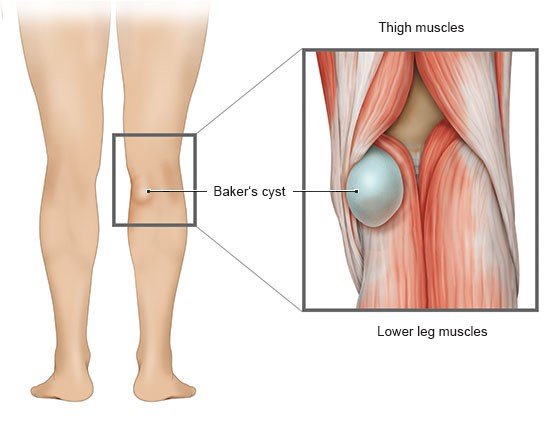Braun J, Müller-Wieland D. Basislehrbuch Innere Medizin. München: Urban und Fischer; 2018.
Brazier BG, Sudekum SA, DeVito PM et al. Arthroscopic Treatment of Popliteal Cysts. Arthrosc Tech 2018; 7(11): e1109-e1114.
Deutsche Gesellschaft für Orthopädie und Orthopädische Chirurgie (DGOOC). Gonarthrose (S2k-Leitlinie, in Überarbeitung). AWMF-Registernr.: 033-004. 2018.
Faller A, Schünke M. Der Körper des Menschen. Einführung in Bau und Funktion. Stuttgart: Thieme; 2020.
Fielding JR, Franklin PD, Kustan J. Popliteal cysts: a reassessment using magnetic resonance imaging. Skeletal Radiol 1991; 20(6): 433-435.
Frush TJ, Noyes FR. Baker's Cyst: Diagnostic and Surgical Considerations. Sports Health 2015; 7(4): 359-365.
Han JH, Bae JH, Nha KW et al. Arthroscopic Treatment of Popliteal Cysts with and without Cystectomy: A Systematic Review and Meta-Analysis. Knee Surg Relat Res 2019; 31(2): 103-112.
Hayashi D, Roemer FW, Dhina Z et al. Longitudinal assessment of cyst-like lesions of the knee and their relation to radiographic osteoarthritis and MRI-detected effusion and synovitis in patients with knee pain. Arthritis Res Ther 2010; 12(5): R172.
Herold G. Innere Medizin. Köln: Herold; 2021.
Janzen DL, Peterfy CG, Forbes JR et al. Cystic lesions around the knee joint: MR imaging findings. AJR Am J Roentgenol 1994; 163(1): 155-161.
Langsfeld M, Matteson B, Johnson W et al. Baker's cysts mimicking the symptoms of deep vein thrombosis: diagnosis with venous duplex scanning. J Vasc Surg 1997; 25(4): 658-662.
Leib A, D., Roshan A, Foris L, A. et al. Baker's Cyst (StatPearls Publishing LLC). 2020.
Li H, Zhang M, Li Y et al. Comparison of clinical outcomes associated with arthroscopic cyst wall preservation or resection in the treatment of popliteal cyst: a systematic review and meta-analysis. Arch Orthop Trauma Surg 2021; 141(10): 1741-1752.
Macfarlane DG, Bacon PA. Popliteal cyst rupture in normal knee joints. Br Med J 1980; 281(6249): 1203-1204.
Miller TT, Staron RB, Koenigsberg T et al. MR imaging of Baker cysts: association with internal derangement, effusion, and degenerative arthropathy. Radiology 1996; 201(1): 247-250.
Neubauer H, Morbach H, Schwarz T et al. Popliteal cysts in paediatric patients: clinical characteristics and imaging features on ultrasound and MRI. Arthritis 2011: 751593.
Sansone V, de Ponti A, Paluello GM et al. Popliteal cysts and associated disorders of the knee. Critical review with MR imaging. Int Orthop 1995; 19(5): 275-279.
Van Nest DS, Tjoumakaris FP, Smith BJ et al. Popliteal Cysts: A Systematic Review of Nonoperative and Operative Treatment. JBJS Rev 2020; 8(3): e0139.
Zhou XN, Li B, Wang JS et al. Surgical treatment of popliteal cyst: a systematic review and meta-analysis. J Orthop Surg Res 2016; 11: 22.
IQWiG health information is written with the aim of helping people understand the advantages and disadvantages of the main treatment options and health care services.
Because IQWiG is a German institute, some of the information provided here is specific to the German health care system. The suitability of any of the described options in an individual case can be determined by talking to a doctor. informedhealth.org can provide support for talks with doctors and other medical professionals, but cannot replace them. We do not offer individual consultations.
Our information is based on the results of good-quality studies. It is written by a team of health care professionals, scientists and editors, and reviewed by external experts. You can find a detailed description of how our health information is produced and updated in our methods.



